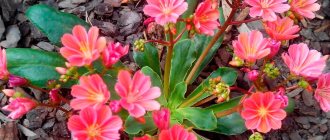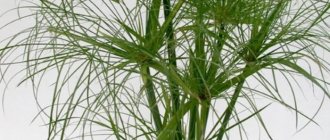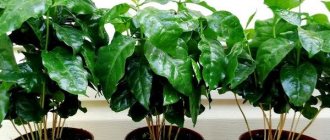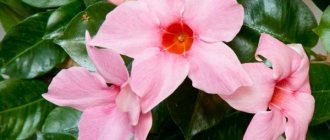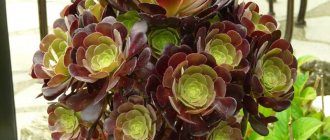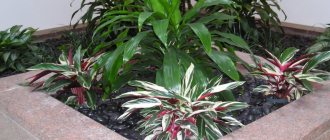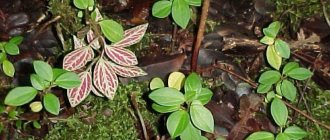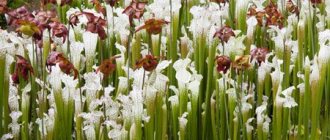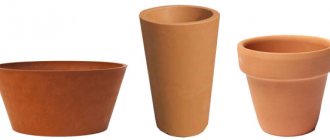Description
Balsam has more than 500 species and hybrids. Its homeland is Africa and Asia. This flower was brought to Europe back in 1596, since then it has not lost its popularity, as it can delight its owners with year-round flowering in the front garden or in a greenhouse. It has many popular names: wisp, impatiens and evergreen. Its stems can reach a length of 50 cm.
The leaves have different colors: green, bronze and reddish-green. They are fleshy and their edges are wavy. When the humidity is high outdoors or indoors, the leaves of the plant become covered with dew, for which the flower received the name “wet Vanka”.
Impeller balsam
Impatiens flowers are located in the axils of the leaves. Their color can be very diverse: yellow, orange, crimson, scarlet, white, lilac, pink and purple. Flower petals may have spots and stripes of contrasting shades.
Hybrids of this plant are distinguished by double flowers and numerous flat leaves. The flowers are small, but when flowering they abundantly decorate the bush.
When the plant fades, green fruits appear in place of the flowers, forming capsules with seeds. When they are fully ripe, at the slightest touch they open and you can collect seeds from them. The flower received the name “touch-me-not” precisely because of this.
But what varieties of garden balsam are there, and what they look like. This information will help you understand.
In the video - ampelous balsam:
Impatiens can be grown as perennials in pots, or as annuals on balconies or in gardens.
Types and varieties of impatiens with photos
The genus Impatiens includes only a small number of species. Several names are bred for cultural purposes, including decorative hybrid varieties. Below we will consider the structural features of the main plant forms of the plant.
Waller's impatiens (Impatiens walleriana)
Presented in the form of a lush spreading bush with bright brown-red leaves. Flowering stems are strewn with buds. The length of the shoots reaches about 60 cm. The leaf blades are attached to oblong petioles. The foliage shape is oval or diamond-shaped. The size of one leaf together with the petiole is approximately 6 cm. This species was used to obtain hybrid mixes that differ in the colors of the buds. These varieties are Symphony, Futura, King Kong, Novett, Colorpower Dark Red and Lavender Flame.
Impatiens Hawkeri
This species laid the basis for the selection of the New Guinea variety. The bushes are characterized by lanceolate blades and voluminous inflorescences. When exposed to bright sunlight, the stems quickly grow and bloom profusely.
Impatiens niamensis (Impatiens niamniamensis)
It stands out for its original fused flowers. The glossy petals form a large bean, colored yellow or red. Double coloring of inflorescences is often observed. Among the varieties of Impatiens Niamey, the “corduroy” variety is especially popular, which has unusual buds that are creamy, like slippers.
Impatiens petersiana
A tall species with a short fleecy layer on the ground parts. Leaf blades peek out from long petioles. Medium sized buds. The color of the petals is predominantly red or scarlet.
Impatiens glandulifera
The species got its name due to the presence of glands located at the base of the leaves. The plant takes root well in the garden, but it belongs to the group of annuals, so it can only serve as a landscaping plant for one season. Whorls, consisting of lanceolate leaves, are located in the upper part of the shoots. The buds bent outward are formed from petals of a burgundy, white or pink hue. The inflorescences are hidden in the axils and collected individually in groups.
Impatiens balsamina
Another heat-loving variety that does not survive the cold season and is grown as an annual. Lush spreading bushes reach a height of about 70 cm. At the tops in the axillary folds there are buds of bright, saturated colors.
Tamarind impatiens (Impatiens tamarinda)
Suitable for indoor breeding and has a modest size. The leaves and flowers are large. This species includes varieties such as white impatiens and purple blue.
Some flower growers prefer to see terry varieties with lush buds in the ranks of their plant pets. We are talking about the common varieties Rosette, Fiesta, Double Duet and Stardust Lavender.
Garden flowers Perennial flowers
Varieties
Thanks to the intensive work of breeders, many varieties and hybrids of ampelous balsam have appeared, which differ in size, color of leaves and flowers.
Among the most common varieties are the following.
| Name | Description |
| Tumbler White | The flowers bloom with a diameter of 4-5 cm, their color is white. |
| Atena Coral Pink | Terry inflorescences are scarlet in color, their diameter is the same as that of the previous variety. |
| Scarlet | The flowers are painted red and are 4-5 cm in diameter. |
| Atena Red Flash | The color of numerous flowers is red with white splashes. |
| Tumblr Rose | The bush is decorated with pink flowers. |
| Violet Star | The dark pink inflorescences have white stripes that extend from the center of the flower and continue to the middle of the petal. |
| Wallera Athena Appleblossom | The diameter of the flowers is from 4 to 5 cm, the outer side of the petals is white, and the inner side is painted pink. |
| Tumbler Salmon | The flowers are salmon-colored, their diameter is from 2.5 to 3.5 cm. |
Botanical description and history
There is no exact information regarding the origin of balsam.
It is only known that its homeland and habitat are the subtropics of North America and Africa. Impatiens was brought to Europe in 1596, after which it gained great popularity. Waller's terry balsam is considered the most decorative. He is the “parent” of many hybrids. Impatiens is a perennial plant, but is often cultivated as an annual. Waller's balsam is different:
- Abundant flowering.
- Juicy, brittle branched stem up to 60 cm high.
- Reddish-brown leaves.
- Shoots are 30 cm long.
Inflorescences appear early. Flowering lasts throughout the year. There are so many flowers that they cover all the leaves. The flowers are 5 cm in diameter. They are solitary or collected in inflorescences. They consist of 5 sepals and a five-membered corolla, connected in pairs or individual petals.
The peduncle is long. The fruit is a capsule. The root system is powerful and grows into drainage holes when there is not enough space.
To this day there is no exact theory regarding the origin of this flower. Many legends have been preserved among the people, but none of them have been confirmed. It is only known that the subtropics of Africa and North America are considered the plant’s homeland. The first plants appeared in Europe in 1596, after which they began to be in great demand. In natural conditions, ampelous balsam prefers warm climates and high humidity.
How and when to plant?
As when planting Primrose, for home decoration, ampelous balsam is planted in early March, and if the flower is located outside, then the seeds are planted at the end of April.
Before planting in the ground, the seed must be prepared; it is placed in a weak solution prepared from potassium permanganate and water. The seeds are kept in it for 24 hours.
While the seeds are being prepared, the soil required for them should be prepared. Impatiens are very sensitive to the composition of the soil; the soil must be well drained and have a slightly acidic environment.
The best option would be to mix it yourself, using:
- 1 part leaf soil;
- 2 parts peat;
- 1 part river sand (coarse-grained);
- 1 part vermiculite.
The last two components make the soil breathable and loose; they allow the soil to dry out in time so that the roots of weak seedlings do not die from excess moisture.
The container for sowing seeds should not be deep; it is enough if it is 8 cm in height. Through holes must be made at the bottom of the selected pot or container, and then a layer of expanded clay, at least 2 cm thick, must be poured into it. Then the container is filled up to the sides soil and watered with a solution of “Fitosporin”, which can prevent the appearance of a disease such as “black leg” on the shoots. You can use a well for irrigation in your dacha.
It will also be interesting to learn how to grow Balsam from seeds at home.
Video on how to grow flowers:
The seeds are placed on the surface of the prepared pot with an even distance from each other, this will ensure uniform germination of the plant. The seeds are lightly pressed, but not completely immersed in the ground, so that they can receive enough light to germinate. Sometimes they are covered with a small layer of sand, but this is not necessary.
After planting the seeds in a pot, it is transferred to a warm and bright place, preferably on a windowsill, but the seedlings must be protected from direct sunlight. But you can learn how to plant a willow from a twig into a pot from this video.
To germinate balsam, you need to create a greenhouse effect; you can cover the container with the seeds with film or place glass on it, then periodically open it and shake off the condensation that collects from it. If you need to moisten the soil with a spray bottle. Sprouts will appear three weeks after planting; if this does not happen, you will have to sow the container with other seeds.
You can find out how Bacopa ampelae is grown from seeds by watching the video.
It will also be interesting to learn about how Tithonia is planted and cared for.
For those who want to learn more about how to grow Amaranth from seeds, you should follow this link: https://2gazon.ru/ozelenenie/cvety/palisadnik/amarant-vyrashhivanie-iz-semyan-kogda-sazhat.html
Maybe
Ampelous impatiens
What are ampelous plants and ampelous annual flowers?
There are many varieties of hanging impatiens. Ampelous impatiens, which is easy to plant and care for, is suitable for decorating terraces, verandas, and gazebos. With its help you can create beautiful and unusual compositions. They look especially good in company with pelargonium.
Highlight F1 Deep Orange
The variety was specially bred for growing in hanging baskets. This is what made it especially popular among gardeners. The bush grows very densely and this allows for a large number of flowers. Care for the Khailat F1 variety is standard; seedlings can be planted in open ground in the first weeks of June.
The orange-red color of the petals stands out especially brightly against the background of dark foliage.
Acrobat
The variety is bred in several varieties, each with a unique flower color. For example, Violet has rich purple petals, and Star has pink inflorescences. The Acrobat Salmon variety has a soft pink color. When choosing a species, it is worth taking into account the flowering period, since for some it is long, while for others it is short. The flowering period of Acrobat is from late May to October. The care is standard, suitable for both open ground and flowerpots.
Important! At home, balsams with proper care can reach a diameter of 60 cm. Such a flowering ball will look very unusual.
Impatiens ampelous, or hanging balsam, is distinguished by easy care and beautiful flowering. It looks impressive both in the apartment and in the garden.
How to care?
When three leaves appear on the seedlings, you will need to pick the seedlings. They can be replanted in peat or plastic cups. Balsam is very moisture-loving, but it should not be overwatered, as this will damage its roots. If the seedlings have grown elongated, they should simply be placed deeper into the ground when picking. After this, the plant still needs greenhouse conditions, so you should not immediately remove the film from the pots; you need to gradually tame the seedlings, sometimes opening the glass or film for a while.
Young balsam shoots soon begin to create mini bushes; if this does not happen, then you need to pinch the tops with them; the more side shoots that come from it, the bushier the plant will be.
After picking, seedlings must be sprayed regularly, especially in hot weather. Once the plant has formed strong roots, it can be planted in open ground or in pots. The right time for this is mid-June.
Video shows how to grow from seeds:
Diseases and pests
In winter, the plant is susceptible to fungal diseases, and gray rot attacks it especially often. It can be eliminated using the following method: clean the roots of the plant from the old soil, replant it in new soil and a pot.
When there is little humidity in the room where balsam grows, spider mites annoy it. The first sign of its settlement on a plant is curled leaves that begin to fall off on their own. Medicines in the form of Karate, Dimitam and Actellik will help you cope with the tick.
The presence of whitefly on balsam bushes is indicated by yellowing leaves. It usually settles on the inside of the lower leaves. You can get rid of it by using special means: Decis, Fufanon and others.
Growing balsam from seeds is not easy, but if you follow all the recommendations, you can eventually get healthy and long-flowering bushes. They will decorate any garden, house and balcony. The decorative effect of the plant is established even during the growth of the seedlings, to enhance it it is worth periodically spraying the plant with “Zircon” or “Kornevin”.
Diseases and pests
Impatiens are affected by aphids and whiteflies; if the air is too dry, they can be affected by spider mites. In case of severe damage, the plant is sprayed with insecticides. Excess moisture promotes the development of gray rot.
In winter, impatiens is susceptible to fungal diseases, gray mold in particular. The plant is removed from the pot, the roots are cleaned and transplanted into another container with a new substrate.
- At elevated temperatures and low humidity, flowering stops and the leaves wither. Dry indoor air causes buds to fall off. Lack of light affects the color of the leaves. Impatiens lose their decorative appearance - the shoots become very elongated.
- Bacteriosis (watery spots on shoots and leaves) develops due to contaminated, over-fertilized soil; high temperature. Spots cover all the leaves and the plant dies. You need to fight the disease at the first signs. The flower is sprayed with Bordeaux mixture.
- If the room humidity is low, the flower may be affected by spider mites. The leaves curl and fall off over time. To combat the pest, the drugs Neoron and Actellik are used. The appearance of whiteflies is signaled by yellowing of the leaves. Treatment is carried out by Fufaron, Decis.
To prevent diseases and pests, you should adhere to the above rules for caring for the plant.
Reviews
- Katerina, 26 years old: “I fell in love with balsam in one of the flower shops, but the price for an adult plant at that time was too high for me, and I decided to grow it myself. I bought seeds in the same store, they were securely hidden in a paper bag that contained a capsule, it contained several small seeds, they were so airy, I was afraid that in any draft they would fly off the pot, because digging them in when planting is not recommended. After the first watering of the soil with a spray bottle, the seeds themselves were pressed into the ground. The first shoots appeared after about three weeks, I already began to worry that they had not sprouted at all. After they grew and were decorated with wide leaves, I transplanted them into peat cups. Some had to be planted in twos because I couldn’t separate their roots. As a result, on my balcony there were three hanging flower pots with hanging thick branches, densely strewn with flowers.” But you can find out what reviews of Balsam Camellia exist by reading this article.
- Olga, 54 years old: “In a garden store I liked a bag of seeds of the terry ampelous balsam variety “ATENA APPLEBLOSSE F1.” There were only 8 seeds in it. Since I had never sprouted seedlings for flowers from seeds, I approached this process with all seriousness. I prepared a special mixture, poured it into a shallow container, and placed the seeds in two rows at a decent distance from each other. Periodically sprayed the ground. And when the entrances appeared, I carefully watched to see that three leaves appeared on them, then transplanted them into small disposable plastic cups. Of the eight seeds, I got five. As soon as the seedlings got stronger, I immediately planted them in hanging pots and hung them on my balcony, it’s glassed, so it’s been decorated with balsam since May.”

